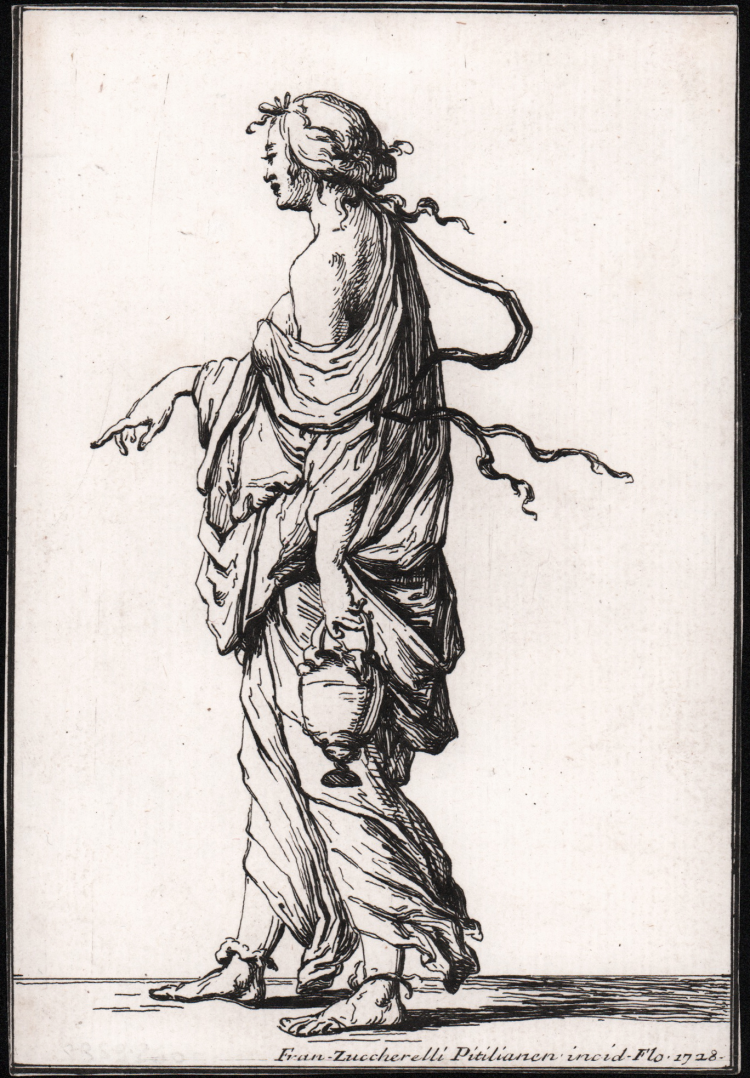



| Reference: | S42142 |
| Author | Francesco ZUCCARELLI |
| Year: | 1728 |
| Measures: | 122 x 172 mm |


| Reference: | S42142 |
| Author | Francesco ZUCCARELLI |
| Year: | 1728 |
| Measures: | 122 x 172 mm |
Etching, signed and dated lower margin: Fran Zuccherelli Pitilianen incid. Flo. 1728.
After a drawing by Giovanni Manozzi.
The print shows a standing female figure walking to the left holding a lamp, pointing with right hand.
Good example, printed on contemporary laid paper, trimmed close to the marginal line, in perfect condition. Cut off the inscription in the lower margin.
Francesco Zuccarelli studied in Florence in Paolo Anesi's workshop and later moved to Rome with the painters Giovanni Maria Morandi and Pietro Nelli. He was initially a painter of historical subjects inspired by his knowledge of the painting of Claude Lorrain, a 17th-century French painter who lived in Rome and who was a master of this genre together with his compatriot, but more scenic, Nicolas Poussin.
After moving to Venice, Zuccarelli turned to painting Arcadian subjects, which he cultivated in competition with Giuseppe Zais from Belluno. As with other Venetian painters of his time, such as Canaletto and Bernardo Bellotto, his painting was much appreciated abroad where he was called to paint for wealthy patrons such as the famous Consul Joseph Smith. Zuccarelli worked extensively in England where he influenced important local painters, and in particular his style was taken up by the great Joshua Reynolds. After five years in London, Zuccarelli returned to Venice. Back in London in 1765, he was one of the founders of the Royal Academy of Arts in 1768.
|
Massar - The prints of Francesco Zuccarelli (3.I) in Print Quarterly (XV) (3) (pp. 247-263).
|
Francesco ZUCCARELLI (Pitigliano 1702 - Firenze 1788)
|
Italian painter and draughtsman, active in England. Zuccarelli’s training began in Florence, where he engraved the frescoes by Andrea del Sarto in SS Annunziata. He then studied in Rome under Paolo Anesi and learnt figure drawing from Giovanni Maria Morandi (1622–1717), although in this he never acquired any great skill. His earliest recorded paintings were Mary Magdalene and St Jerome (both untraced), which he contributed to the exhibition of the feast of St Luke in Florence in 1729. He also painted portraits. Around 1730 he moved to Venice and began painting landscapes exclusively. His interest in this field may have led to his becoming acquainted with the Welsh landscape painter Richard Wilson in 1750–51. Wilson painted a lively portrait of him (1751; London, Tate) in exchange for one of Zuccarelli’s landscapes. Zuccarelli avoided both the topographical type of Venetian view developed by Canaletto and the stormier landscapes of Marco Ricci, adopting instead a decorative landscape style of idealized Italian countryside. His subject-matter was usually unspecific rather than recognizably historical, biblical or mythological. For example, in the early 1740s he executed six paintings purporting to be scenes from the story of Jacob, but the paintings themselves bear few references to it.
|
|
Massar - The prints of Francesco Zuccarelli (3.I) in Print Quarterly (XV) (3) (pp. 247-263).
|
Francesco ZUCCARELLI (Pitigliano 1702 - Firenze 1788)
|
Italian painter and draughtsman, active in England. Zuccarelli’s training began in Florence, where he engraved the frescoes by Andrea del Sarto in SS Annunziata. He then studied in Rome under Paolo Anesi and learnt figure drawing from Giovanni Maria Morandi (1622–1717), although in this he never acquired any great skill. His earliest recorded paintings were Mary Magdalene and St Jerome (both untraced), which he contributed to the exhibition of the feast of St Luke in Florence in 1729. He also painted portraits. Around 1730 he moved to Venice and began painting landscapes exclusively. His interest in this field may have led to his becoming acquainted with the Welsh landscape painter Richard Wilson in 1750–51. Wilson painted a lively portrait of him (1751; London, Tate) in exchange for one of Zuccarelli’s landscapes. Zuccarelli avoided both the topographical type of Venetian view developed by Canaletto and the stormier landscapes of Marco Ricci, adopting instead a decorative landscape style of idealized Italian countryside. His subject-matter was usually unspecific rather than recognizably historical, biblical or mythological. For example, in the early 1740s he executed six paintings purporting to be scenes from the story of Jacob, but the paintings themselves bear few references to it.
|